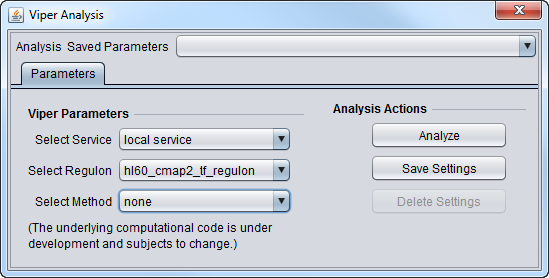Difference between revisions of "Viper Analysis"
| Line 1: | Line 1: | ||
Page in preparation, should be available 11/22/2013. | Page in preparation, should be available 11/22/2013. | ||
| − | (Virtual Inference of Protein-activity by Enriched Regulon analysis.) | + | (Virtual Inference of Protein-activity by Enriched Regulon analysis) |
| + | |||
| + | The VIPER component in geWorkbench transforms the expression profile for each sample (column) into a transcription-factor activity profile. The activity of each transcription factor is inferred from that of its targets, where the targets are obtained from a cell-context-specific interaction network (interactome). Three cell-context-specific interactomes are supplied, for leukemia, breast cancer, and prostate cancer. | ||
==Data== | ==Data== | ||
Revision as of 16:16, 21 November 2013
Page in preparation, should be available 11/22/2013.
(Virtual Inference of Protein-activity by Enriched Regulon analysis)
The VIPER component in geWorkbench transforms the expression profile for each sample (column) into a transcription-factor activity profile. The activity of each transcription factor is inferred from that of its targets, where the targets are obtained from a cell-context-specific interaction network (interactome). Three cell-context-specific interactomes are supplied, for leukemia, breast cancer, and prostate cancer.
Data
VIPER requires expression data that is already in a form where the values for each sample are relative to a control value.
Parameters
- Select Service
- Local Service - run VIPER on an instance of R installed on the same machine as geWorkbench.
- Web service - not yet implemented. Run Viper on a remote server.
- Select Regulon
- hl60_cmap2_tf_regulon - Human promyelocytic leukemia, CMAP2 data
- mcf7_cmap2_tf_regulon - Breast adenocarcinoma, CMAP2 data
- pc3_cmap2_tf_regulon - Prostate cancer, CMAP2 data
- Select Method
- none - use if the data is already in rank format.
- scale - for each gene (row in dataset), calculate the mean and standard deviation across all columns, then subtract the mean from each value in the row, and divide each by the standard deviation.
- rank - rank transform row-wise
- mad - subtract the median, divide by the mean absolute deviation (MAD)
- ttest - for each gene, perform a t-test comparing each sample (column) one-at-a-time against all other samples taken together.

